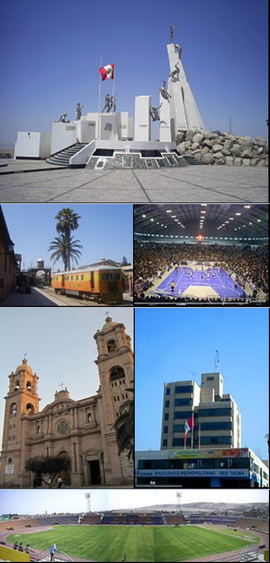Tacna
| Tacna | |
|---|---|
|
Coordinates: 18 ° 1 ′ S , 70 ° 14 ′ W
Tacna on the map of Peru
|
|
| Basic data | |
| Country |
|
| region | Tacna |
| province | Tacna |
| City foundation | 1572 |
| Residents | 86,977 (2017) |
| - in the metropolitan area | 286.240 |
| City insignia | |
| Detailed data | |
| height | 552 m |
| Waters | Río Caplina |
| Time zone | UTC -5 |
| City Presidency | Julio Medina Gomez (since 2019) |
| Website | |
|
above monument of the Alto de la Alianza 2. left Ferroviaria Railroad Station 2. right interior view of Tacna sports stadium 3. left Tacna Cathedral 3. right building in the center of Tanca
below Jorge Basadre Stadium |
|
Tacna is the capital of the Tacna region of the South American Andean state of Peru . Which is in the same district Tacna Province Tacna . It is located 552 meters above sea level. In the 2017 census, there were 86,977 people in the urban area and 286,240 in the metropolitan area.
Location and cityscape
Tacna is located on the Río Caplina , 56 kilometers from Arica , about the same distance from the sea coast and 1,295 km southeast of the Peruvian capital Lima and near the border with Chile . The city is of strategic importance due to its border location.
The cathedral, designed by Gustave Eiffel and begun in 1872, is located on Paseo Cívico . There are also the bronze statues of Admiral Miguel Grau Seminario and Colonel Francisco Bolognesi . There is also a history museum , the railway museum , the Universidad Nacional Jorge Basadre Grohmann and the permanent motorsport racing track Autódromo Tacna in the city .
history
The city was founded in 1572 by the Spanish conquerors .
Tacna was the capital of the short-lived Peruvian-Bolivian Confederation . During the Saltpeter War there was a battle between Peruvian and Chilean troops on May 26, 1880 above the city on the Campo de la Alianza, in which the Chileans were victorious. In the Treaty of Ancón of October 20, 1883, Tacna was then initially awarded to Chile. However, it was agreed that after 10 years a referendum should be held on whether the city would belong to Peru or Chile. This referendum did not take place because the two parties could not agree on the terms of the referendum.
Only in 1929 was the open dispute over the two cities of Tacna and Arica resolved in the Lima Treaty on the basis of an arbitration ruling by US President Calvin Coolidge from 1925. Since 1929 Tacna has belonged to Peru and Arica to Chile.
In June 2001 Tacna and its region was hit by an earthquake .
Climate table
| Tacna | ||||||||||||||||||||||||||||||||||||||||||||||||
|---|---|---|---|---|---|---|---|---|---|---|---|---|---|---|---|---|---|---|---|---|---|---|---|---|---|---|---|---|---|---|---|---|---|---|---|---|---|---|---|---|---|---|---|---|---|---|---|---|
| Climate diagram | ||||||||||||||||||||||||||||||||||||||||||||||||
| ||||||||||||||||||||||||||||||||||||||||||||||||
|
Average monthly temperatures and rainfall for Tacna
Source: WMO
|
|||||||||||||||||||||||||||||||||||||||||||||||||||||||||||||||||||||||||||
Tacna has a mild desert climate ( BWn )
sons and daughters of the town
- Ricardo Jaimes Freyre (1868–1933), writer and diplomat
- Federico Gerdes (1873–1953), composer, conductor and pianist
- Jorge Basadre Grohmann (1903–1980), historian
- Lautaro Murúa (1925–1995), actor and director
- Francisco José Lombardi (* 1947), film director and producer
- Fernando Zavala (* 1971), politician
Individual evidence
- ^ Peru: Region Tacna - Provinces & Places . www.citypopulation.de. Retrieved December 23, 2019.
- ↑ Perú: Perfil Sociodemográfico (PDF, 27.4 MB) Instituo Nacional de Estadistica e Informatica (INEI). August 2018. Retrieved December 19, 2019.
- ↑ President Coolidge’s award on Tacna-Arica . In: European Talks ; Edited by Albrecht Mendelssohn Bartholdy , vol. 3 (1925), issue 4, p. 265ff.
- ^ William Jefferson Dennis: Tacna and Arica. An account of the Chile-Peru Boundary dispute and of the Arbitrations by the United States . Yale University Press, New Haven 1931.


